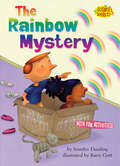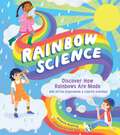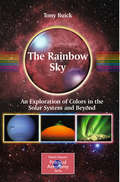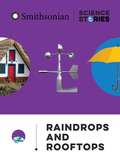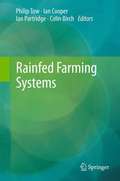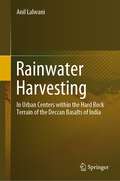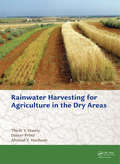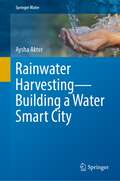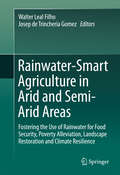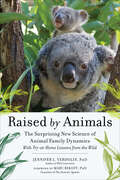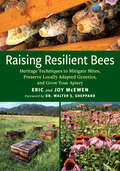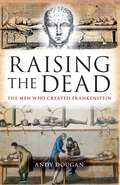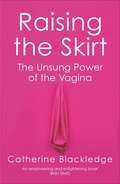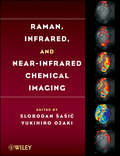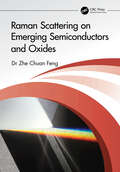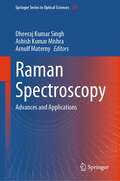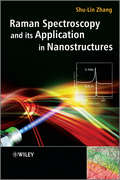- Table View
- List View
The Rainbow Mystery
by Jennifer DusslingTwo curious kids conduct experiments and build a prism in order to figure out how rainbows form.
The Rainbow Mystery (Science Solves It!)
by Jennifer DusslingSolve kid-sized dilemmas and mysteries with the Science Solves It! series. These fun books for kids ages 5–8 blend clever stories with real-life science. Why did the dog turn green? Can you control a hiccup? Is that a UFO? Find the answers to these questions and more as kid characters dive into physical, life, and earth sciences. Colors on the loose! Annie and Mike are making a box fort when a bunch of little rainbows mysteriously appear on the family room wall. Are they from a sprinkler? A gas puddle? A necklace? Annie and Mike need scientific detective skills to solve this rainbow mystery! Books in this perfect STEM series will help kids think like scientists and get ahead in the classroom. Activities and experiments are included in every book! (Level Two; Science topic: Rainbows)
Rainbow Science: Discover How Rainbows Are Made, with 23 Fun Experiments & Colorful Activities!
by Artemis RoehrigThis colorful book explores the fascinating science of rainbows and includes a pair of fun prism glasses so kids can see rainbows right before their eyes! I spy a rainbow! But where do rainbows come from? How are they made? Rainbow Science celebrates everything rainbow, from the science of sunlight to the prism in raindrops to how our eyes see all the colors that make up a rainbow, in this colorful activity book. Kids can be a rainbow scientist and learn how to search for rainbows, make their own rainbows with a hose, spin homemade color wheels, blow multicolored bubbles, make a kaleidoscope, and more. Simple materials lists and straightforward, age-appropriate experiment steps are accompanied by scientific explanations for each activity. Engaging illustrations give easy-to-understand explanations about rainbow science and the math and physics of light refraction. Tucked into the pocket on the inside front cover is a fun pair of wearable glasses so kids can see rainbows right before their eyes. This book is a celebration of rainbows for kids who love science experiments, weather, and hands-on activities!
The Rainbow Sky
by Tony BuickThere are many more astronomical and meteorological phenomena involving color than most people are aware of, let alone have observed. Visual double stars with contrasting color are obvious targets for amateur astronomers, but there are many more - everything from colors on the Moon, through colors on the planets and in deep-sky objects, to man-made colors in the night sky. A great deal of these colored phenomena can be seen with the unaided eye, and can be visible in - and imaged with - a modest telescope, but all require preparation, anticipation and planning. The result will be some breathtaking sights, along with some amazing images. Just browsing through this book will captivate the reader. Some events are familiar but present severe challenges to photograph. Some can be captured only by using previously unfamiliar techniques. And it is almost certain that some will never have been seen before by readers. All the colored objects and phenomena are accessible by using the right techniques, for which Tony Buick provides easy-to-follow instructions.
Raindrops and Rooftops: Below-Grade Reader (Smithsonian Science Stories)
by Smithsonian InstitutionGrade 3. 2018. 56 pages. Lexile range: 510–560L. Raindrops and Rooftops reader serves as an informational text resource that is incorporated into many lessons in the Smithsonian Science for the Classroom™ module How Do Weather and Climate Affect Our Lives? Topics include: Weather Woman; Surprise! It's Raining; Climate Tour; Wild and Wacky Weather; Gusts and Gales; Up on the Rooftop; and Don't Rain on the Parade.
Rainfed Farming Systems
by Ian Partridge Philip Tow Colin Birch Ian CooperWhile a good grasp of the many separate aspects of agriculture is important, it is equally essential for all those involved in agriculture to understand the functioning of the farming system as a whole and how it can be best managed. It is necessary to re-assess and understand rain-fed farming systems around the world and to find ways to improve the selection, design and operation of such systems for long term productivity, profitability and sustainability. The components of the system must operate together efficiently; yet many of the relationships and interactions are not clearly understood. Appreciation of these matters and how they are affected by external influences or inputs are important for decision making and for achieving desirable outcomes for the farm as a whole. This book analyses common rain-fed farming systems and defines the principles and practices important to their effective functioning and management.
Rainfed Farming Systems
by Ian Partridge Philip Tow Colin Birch Ian CooperWhile a good grasp of the many separate aspects of agriculture is important, it is equally essential for all those involved in agriculture to understand the functioning of the farming system as a whole and how it can be best managed. It is necessary to re-assess and understand rain-fed farming systems around the world and to find ways to improve the selection, design and operation of such systems for long term productivity, profitability and sustainability. The components of the system must operate together efficiently; yet many of the relationships and interactions are not clearly understood. Appreciation of these matters and how they are affected by external influences or inputs are important for decision making and for achieving desirable outcomes for the farm as a whole. This book analyses common rain-fed farming systems and defines the principles and practices important to their effective functioning and management.
Rainwater Harvesting: In Urban Centers within the Hard Rock Terrain of the Deccan Basalts of India
by Anil LalwaniOur dependency on groundwater resources and overuse thereof has led to a decline in water table so that in the last couple of decades the focus has shifted back to the traditional practices of rainwater harvesting, and ways and means have been sought to promote Rainwater harvesting in Urban areas to recharge the stressed groundwater systems. This book discusses in brief the classifications of Rainwater harvesting, and the various rainwater harvesting systems that are currently applied. The most important aspect for achieving any groundwater recharge is the availability of source water, this can be evaluated by analyzing the monsoon rainfall pattern, its frequency, number of rainy days, and maximum rainfall in a day and its variation in space and time. The Deccan basalts are one of the most enigmatic rocks in India and pose a very difficult task when it comes to ground water exploration and groundwater recharge, especially in the urban areas where due to constraint of space one needs to resort to borewells for recharge purpose. It is important for any such undertaking to understand the applicability and sustainability aspects of Rainwater harvesting as it is being practiced. This book tries to differentiate the Basaltic Aquifers from the other hard-rock Aquifers, and highlights the difficulties in trying to implement rainwater harvesting by groundwater recharge with the basaltic terrain. It also deals with the issue of long term sustainability of roof top Rainwater to meet the growing demands of fresh water. It also highlights some of the shortcomings in the methodologies used and the requirements for being considered in the various categories of green building rating agencies. It furthermore clarifies the possibility and limitations of dependence of roof top harvesting in addressing the question of water shortages, which is of common occurrence within most urban centres of India. It also helps in clarifying major misconceptions that are currently prevailing regarding Roof top Rainwater harvesting especially within the low capacity aquifers within the hard rock terrain of the Deccan basalts.
Rainwater Harvesting for Agriculture in the Dry Areas
by Theib Y. Oweis Dieter Prinz Ahmed Y. HachumDry areas suffer not only from limited rainfall but alsonatural leakage'-90% of rainwater is lost directly or indirectly, and is unavailable for agriculture or domestic use. Water harvesting is a low-cost, easy-to-use, environmentally-friendly way to recover a large part of this lost water. How does water harvesting work? Which sites or areas are
Rainwater Harvesting—Building a Water Smart City (Springer Water)
by Aysha AkterThis book introduces the readers to possible aspects of the rainwater harvesting system against urbanization to plan, design, and implement. Practical applications of rainwater harvesting to supplement potable water, stormwater management, greywater reuse, and managed aquifer recharge are included. Along with conventional practices, advanced technologies for conceptualizing, data collection and processing, test procedures, and design principles are provided to illustrate the theory. This book is a pathway to a water smart city, example problems reflect the solutions for harvested water quantity and/or quality and afterward. Socio-economic assessments are incorporated to explore comprehensive knowledge. The book covers an interdisciplinary field, thus, suitable for students, researchers, and professionals associated with rainwater harvesting system development and management
Rainwater-Smart Agriculture in Arid and Semi-Arid Areas
by Walter Leal Filho Josep de Trincheria GomezThis book introduces state-of-the-art approaches, methods and research, focusing on smart management of rainwater. In addition, it provides an overview of projects from across the world, illustrating how rainwater-smart management has been implemented in drylands. Focusing on the scientific perspective it demonstrates how rural dryland agriculture can be improved. It also documents the wealth of rainwater-smart know-how available today, and replicates and transfers results to other countries and regions, to encourage cross-sector interactions among various stakeholders, such as practitioners from governmental and public organisations, policy- and decision-makers, and teaching staff from academic scientific institutions. The contributors showcase vital lessons learned from research, field projects and best-practice examples. They address the integrated use of rainwater harvesting management with landscape restoration practices and water-, and climate-smart agriculture for food security and poverty alleviation in arid and semi-arid areas. Original research, combined with the contributors’ synthetic approach, lays a foundation for new concepts and ideas. Through case studies and research reports, the book discusses all the relevant issues necessary for the comprehensive analysis and successful implementation of the technologies in rainwater management. Highlighting the working principles and technical recommendations with regard to cost-efficient rainwater-smart solutions, it is of interest to practitioners. It is also a valuable resource for academic specialists, professionals and students, since many development agencies are funding rainwater harvesting for irrigation purposes.
Raised by Animals: The Surprising New Science of Animal Family Dynamics
by Jennifer L. VerdolinWhen it comes to family matters, do humans know best? Leading animal behaviorist Dr. Jennifer Verdolin argues otherwise in this eye-opening book. Welcome to the wild world of raising a family in the animal kingdom . . . sometimes shocking, often ingenious! Every species can surprise us: Chimps have a knack for minimizing temper tantrums, and owl chicks have a remarkable gift for sharing. A prairie vole knows exactly when his stressed-out partner needs a massage. And anyone who considers reptiles “cold-blooded” should consider the caecilian, a snakelike animal from Kenya: After laying eggs, the mother grows a fatty layer of skin, which her babies eat after hatching (not one of the book’s many lessons from the wild to be tried at home!). Along the way Verdolin challenges our often counterproductive beliefs about what families ought to be like and how we should feel. By finding common ground with our furry, feathered, and even slimy cousins, we can gain new insight on what “natural” parenting really means—and perhaps do a better job of forgiving ourselves for those days when we’re “only human”!
Raising Oysters (Fountas & Pinnell LLI Purple #Level R)
by Sarah BrockettSome people think oysters are gross, slimy blobs. Others think these slippery shellfish taste wonderfully delicious. Some people value oysters for their possible secret treasure: a pearl growing inside.
Raising Resilient Bees: Heritage Techniques to Mitigate Mites, Preserve Locally Adapted Genetics, and Grow Your Apiary
by null Eric Mcewen null Joy Mcewen&“Right from the start, this book takes you on a journey that is fascinating and thought-provoking. . . The McEwens demonstrate creative, out-of-the-box thinking and challenge traditional ways of keeping bees.&”—American Bee JournalWith over 100 color photographs and illustrations, Raising Resilient Bees is the comprehensive source for new and experienced beekeepers, offering a sustainable, natural, and repeatable model of care for hive health and production.Global pests and diseases present an unprecedented challenge for the modern honey bee. Hobby and commercial beekeepers alike continue to experience troubling rates of mortality for their colonies, with potentially deleterious consequences for the stability of our wider ecosystems and overall food security. It is time for a global focus on restoring the health of the shared apiary through naturally reared, genetically diverse, and resilient lines of bees.Raising Resilient Bees establishes these parameters and provides guidance for new and experienced beekeepers alike to translate these goals into real practice, thereby safeguarding the honey bee from the unknown threats of the future.Authors Eric and Joy McEwen take two decades worth of beekeeping experience, experiments, and professional production to deliver groundbreaking methods in queen-rearing, varroa mite management, and Natural Nest hive design. Inside, you&’ll discover:Revived and adapted heritage Integrated Pest Management techniquesHow to naturally rear queens and select for resilient, mite-resistant genetic lines without relying on swarming or graftingKey tenets of apicentric beekeepingAdvice for establishing a flourishing and sustainable business with beekeeping at the centerHow to naturally rear bees with distinctive characteristics suitable to their localeAs in large-scale agriculture, the trend toward genetic homogenization is having long-term implications for bees&’ capacity to withstand diverse environmental stressors. With expert advice, enthusiasm, and easy-to-follow instructions, Raising Resilient Bees delivers important and timely information for every beekeeper to create a healthier future.&“Vivid, practical, evidence-based . . . . Biodynamic and organic beekeepers will applaud the authors&’ use of &‘natural nest hives&’ with single-size boxes and vertically uninterrupted brood nests, populated with locally adapted bees and naturally reared queens.&”—David Heaf, author of The Bee-Friendly Beekeeper; bee-friendly.co.uk&“The McEwens look at every aspect of a honey bee&’s life in this book—pest and disease issues, living space, the genetics of resistance and tolerance, qualities of successful queens, optimal feeding, and seasonal management that fits the bee above the beekeeper.&”—Kim Flottum, author of The Backyard Beekeeper; podcast producer, Growing Planet Media
Raising the Dead: The Men Who Created Frankenstein
by Andy DouganA &“pleasingly ghoulish&” look at the real-life Dr. Frankensteins of the nineteenth century and their legacy in modern medicine (Telegraph). Mary Shelley's 1818 novel, Frankenstein, introduced readers to the concept of raising the dead through scientific procedures. Those who read the book were thrilled by this incredible Gothic adventure. Few, however, realized that Shelley&’s story had a basis in fact. Her modern Prometheus was a serious pursuit for some of the greatest minds of the early nineteenth century. It was a time when scientists genuinely believed, as Frankenstein did, that they could know what it feels like to be God. Raising the Dead is the story of the science of galvanism—named after the Italian scientist Luigi Galvani, who had conducted the original experiments—a movement that investigated the theory of &“animal electricity,&” a unifying vital spirit that animates us all, with leaders who believed that they stood on the brink of immortality. While they ultimately failed in this challenge, their studies mapped out the nervous system and made valuable and enduring contributions to medical knowledge and understanding—from theorizing the concepts of the modern-day defibrillator to the use of deep brain stimulus to treat personality disorders to experimental procedures using microchip-controlled devices to bridge damaged spinal nerves. This &“excellent, highly readable history&” tells their stories (Herald).
Raising the Skirt: The Unsung Power of the Vagina
by Catherine Blackledge'A meticulous guide not only to the vagina but to changing perceptions of womanhood' OBSERVER'An empowering and enlightening book' IRISH TIMESThe vagina is the ultimate symbol of female power. Sexual power, creative power and the power to prevent harm. For too long, though, the true extent of vaginal power has been ignored, hidden and misrepresented. Raising the skirt: the unsung power of the vagina reveals this revolutionary view of female genitalia and points the way to a new understanding of what it means to be female. An inspiration for millennia, the vagina is actually a muscular marvel of engineering - sensitive and strong, fluid and flexible. Far from being a passive vessel, female genitalia control the most important role of all: the survival of the species.Originally published as THE STORY OF V: OPENING PANDORA'S BOX
Raising the Skirt: The Unsung Power of the Vagina
by Catherine Blackledge'A meticulous guide not only to the vagina but to changing perceptions of womanhood' OBSERVER'An empowering and enlightening book' IRISH TIMESThe vagina is the ultimate symbol of female power. Sexual power, creative power and the power to prevent harm. For too long, though, the true extent of vaginal power has been ignored, hidden and misrepresented. Raising the skirt: the unsung power of the vagina reveals this revolutionary view of female genitalia and points the way to a new understanding of what it means to be female. An inspiration for millennia, the vagina is actually a muscular marvel of engineering - sensitive and strong, fluid and flexible. Far from being a passive vessel, female genitalia control the most important role of all: the survival of the species.Originally published as THE STORY OF V: OPENING PANDORA'S BOX
Raman and His Effect: Vignettes in Physics
by G. VenkataramanThis book deals with the famous Scattering Effect discovered by Sir C.V. Raman. It gives us deep insights into the character of this famous scientist and vividly describes the circumstances surrounding the discovery.
Raman, Infrared, and Near-Infrared Chemical Imaging
by Slobodan A IcAn all-inclusive guide on the analytical methods of Raman, infrared, and near-infrared chemical imaging An underutilized technology, chemical imaging through Raman, infrared (IR), and near-infrared (NIR) is beginning to gain recognition for its non-destructive method of permitting visualization of spatially resolved chemical information. This type of analysis is triggering a groundswell of demand as manufactured materials become more complex and the need for greater scrutiny and less damaging research practices is at a premium. Concentrating on the applications of chemical imaging, this book presents a thorough background on the theory, software, and hardware employed in this analytical technique. With full examination of this rapidly growing field, this book: Combines many different aspects and applications into one comprehensive volume Discusses how chemical imaging techniques have expanded greatly in terms of instruments and applications, but have lagged in general awareness among scientists and industries that would benefit the most from them Describes chemical imaging uses in key areas-biomedical, pharmaceutical, food, and polymer research Has chapters that outline hardware and instrumentation for the different methods of chemical imaging Encapsulating analytic methods without complicating the subject matter, this book shows where chemical imaging has been successfully applied, inspiring researchers to cultivate the exciting capabilities rooted within this powerful and multifaceted technology.
Raman Scattering on Emerging Semiconductors and Oxides
by Zhe FengRaman Scattering on Emerging Semiconductors and Oxides presents Raman scattering studies. It describes the key fundamental elements in applying Raman spectroscopies to various semiconductors and oxides without complicated and deep Raman theories.Across nine chapters, it covers:• SiC and IV-IV semiconductors,• III-GaN and nitride semiconductors,• III-V and II-VI semiconductors,• ZnO-based and GaO-based semiconducting oxides,• Graphene, ferroelectric oxides, and other emerging materials,• Wide-bandgap semiconductors of SiC, GaN, and ZnO, and• Ultra-wide gap semiconductors of AlN, Ga2O3, and graphene.Key achievements from the author and collaborators in the above fields are referred to and cited with typical Raman spectral graphs and analyses. Written for engineers, scientists, and academics, this comprehensive book will be fundamental for newcomers in Raman spectroscopy.Zhe Chuan Feng has had an impressive career spanning many years of important work in engineering and tech, including as a professor at the Graduate Institute of Photonics & Optoelectronics and Department of Electrical Engineering, National Taiwan University, Taipei; establishing the Science Exploring Lab; joining Kennesaw State University as an adjunct professor, part-time; and at the Department of Electrical and Computer Engineering, Southern Polytechnic College of Engineering and Engineering Technology. Currently, he is focusing on materials research for LED, III-nitrides, SiC, ZnO, other semiconductors/oxides, and nanostructures and has devoted time to materials research and growth of III-V and II-VI compounds, LED, III nitrides, SiC, ZnO, GaO, and other semiconductors/oxides.Professor Feng has also edited and published multiple review books in his field, alongside authoring scientific journal papers and conference/proceeding papers. He has organized symposiums and been an invited speaker at different international conferences and universities. He has also served as a guest editor for special journal issues.
Raman Spectroscopy: Advances and Applications (Springer Series in Optical Sciences #248)
by Dheeraj Kumar Singh Ashish Kumar Mishra Arnulf MaternyThis book highlights recent advances of spectroscopic techniques based on Raman scattering. Different applications are introduced that serve as examples for the versatile use of Raman techniques. Raman spectroscopy is a marker free technique, which is capable of yielding detailed information about molecular systems in a non-destructive way. This makes it a valuable tool for, e.g., material science or medical research. The access to vibrational energy and dynamics yields fundamental insights into static and dynamical structural properties of molecules being influenced by and influencing their material science or medical research environment. The better understanding of the basic building blocks of materials helps to improve the functionality in various applications. Raman spectroscopy has become a truly interdisciplinary research tool, and the ongoing development of techniques makes it attractive for growing variety of scientific and industrial applications, which will be demonstrated in the book. While the “classical” linear spontaneous Raman spectroscopy is restricted in its applicability due to low signal intensities or the excitation of strong fluorescence background, new techniques have helped to overcome such problems. Examples, presented in the book, are surface-enhanced Raman scattering (SERS), and various associated techniques are used to drastically increase signal intensity, confocal, and tip-enhanced Raman scattering (TERS) allowing for high and even sub-diffraction limited spatial resolutions, coherent anti-Stokes Raman scattering (CARS) avoiding fluorescence background and allowing for time-resolved observations of vibrational dynamics, or hyper- and resonance Raman scattering influencing the scattering based on electronic resonances, etc.
Raman Spectroscopy and its Application in Nanostructures
by Shu-Lin ZhangRaman Spectroscopy and its Application in Nanostructures is an original and timely contribution to a very active area of physics and materials science research. This book presents the theoretical and experimental phenomena of Raman spectroscopy, with specialized discussions on the physical fundamentals, new developments and main features in low-dimensional systems of Raman spectroscopy.In recent years physicists, materials scientists and chemists have devoted increasing attention to low-dimensional systems and as Raman spectroscopy can be used to study and analyse such materials as carbon nanotubes, quantum wells, silicon nanowires, etc., it is fast becoming one of the most powerful and sensitive experimental techniques to characterize the qualities of such nanostructures.Recent scientific and technological developments have resulted in the applications of Raman spectroscopy to expand. These developments are vital in providing information for a very broad field of applications: for example in microelectronics, biology, forensics and archaeology. Thus, this book not only introduces these important new branches of Raman spectroscopy from both a theoretical and practical view point, but the resulting effects are fully explored and relevant representative models of Raman spectra are described in-depth with the inclusion of theoretical calculations, when appropriate.
Raman Spectroscopy for Nanomaterials Characterization
by Challa S.S.R. KumarFirst volume of a 40-volume series on nanoscience and nanotechnology, edited by the renowned scientist Challa S.S.R. Kumar. This handbook gives a comprehensive overview about Raman spectroscopy for the characterization of nanomaterials. Modern applications and state-of-the-art techniques are covered and make this volume essential reading for research scientists in academia and industry.

